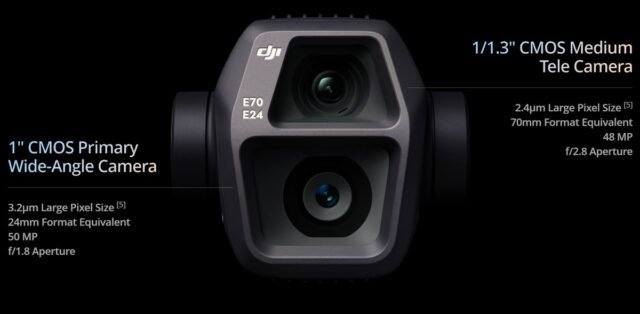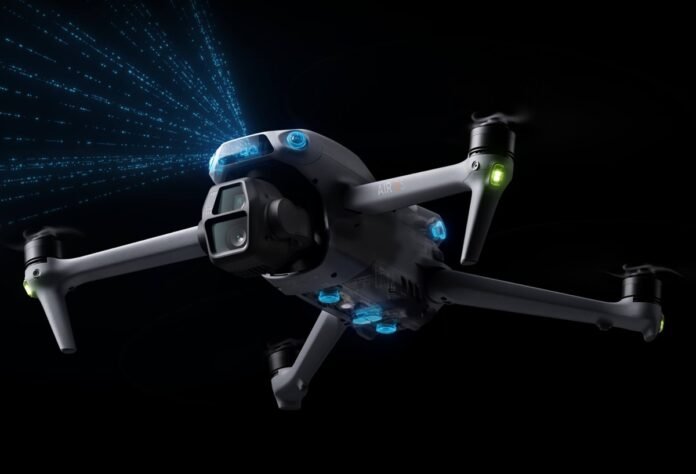From all the DJI consumer drone series (Phantom, Mavic Pro, Air, and MINI) that I tested and reviewed, I like the Air family the most. The Air lineup has the best balance between flight performance, camera capabilities, and price, and it gets better with every new generation. Apparently, the biggest upgrade of the Air 3S from its predecessor is the new 1″ sensor, which can reproduce more details.
The DJI 3S, as indicated by its name, is an upgrade to the Air 3, released last summer. Even with the slight name change, this is far from just a simple refresh. It not just has a new camera but also an improved obstacle avoidance system with advanced LIDAR system for safer night flights.
While both third-generation DJI AIR drones are powered by a 4S 4276 mAh Li-ion pack, the older non-S version has one minute longer air time (46 vs 45 minutes). The deference can come for the extra weight (724g vs 720g) and from the more powerful hardware. This weight-class puts them in the C1 category of drones.
DJI Air 3S: Dual-camera system
As mentioned, the DJI Air 3S features a dual-camera array with 24mm (35mm EFL) wide-angle and 70mm (35mm EFL) medium-telephoto options for easy switching. Both installed on the same 3-axis gimbal. The wide-angle camera has a 1″ 50MP CMOS sensor and the
medium-tele camera, a 1/1.3″ 48MP image sensor. Both cameras come with fixed-aperture lenses, so videographers should consider acquiring DJI’s ND filter set to achieve slower shutter speeds on sunny days.
Additionally, the cameras offer digital zoom, but this noticeably softens video quality. This feature is great for search-and-rescue missions, but otherwise, you should avoid using it to maintain the sharpness and clarity of your videos and photos.

The DJI Air 3S features 42GB of built-in storage, along with micro-SD expansion, ensuring you can capture all your footage during its maximum flight time of 45 minutes. You can easily transfer files wirelessly to your phone or connect via a USB-C cable to your computer.
Pricing, availability, and package options
The DJI Air 3S has been available for purchase since its announcement on October 15, 2024. The base kit, which consists of the drone, a flight battery and the RC-N3 controller, costs $1,099 / £959 / AU$1,699. There are also two Fly More Combo bundle kits available. These include the drone, three batteries, a 3-way charging hub, an ND filter set and a shoulder bag, in addition to a radio controller (RC N2 or RC N3).
Key features
- [Dual camera system] DJI Air 3S features a dual-camera system consisting of a 1-inch-CMOS primary camera and a 1/1.3-inch-CMOS medium telephoto camera. The primary camera features a larger CMOS sensor and a 24mm lens, making it ideal for capturing expansive landscapes with enhanced clarity and a wide field of view. The 70mm medium tele-camera excels at portrait and vehicle shots, offering compressed depth of field to highlight any subject with a bolder, more cinematic look.
- [10-bit D-Log M & HLG Video] Even in normal color mode, Air 3S can record 10-bit video using H.265 encoding, delivering refined color performance and greater flexibility in post, with the maximum ISO raised to 12,800. In D-Log M and HLG color modes, the maximum ISO is raised to 3,200, allowing for greater brightness and more details in urban night scenes.
- [Omnidirectional Vision Sensing System] DJI Air 3S supports the Advanced Pilot Assistance Systems (APAS). Additionally, as the first DJI drone to feature forward-facing LiDAR, Air 3S also features a downward infrared time-of-flight (ToF) sensor and six vision sensors (two at the front, rear, and bottom) to achieve nightscape omnidirectional obstacle sensing. [2] This feature enables the drone to automatically identify and circumvent obstacles, such as buildings, during its flight and return paths, ensuring robust safety for nighttime photography.
- [A New Air Aesthetic] DJI Air 3S features ActiveTrack 360° to keep any subject optimally in frame. Based on the surrounding flight environment, it automatically plans a flight path and adjusts framing to ensure stronger shots that keep your subject the center of attention.
- [Outstanding Air Time] With up to 45 minutes of flight time, Air 3S gives you enough time to scout locations, compose, nail your shots, and do it all over again and again.
- [10-bit 20KM O4 Video Transmission] Powered by OcuSync 4 FHD video transmission technology, Air 3S delivers 10-bit video transmission at 1080p/60fps over distances of up to 20 kilometers. Live feeds are reliably smooth and vivid, with ultra-responsive control for an improved overall flight experience.
DJI Air 3S vs DJI Air 3: What’s new?
I’ve compared the key specs of the Air 3 and the Air 3S in the table below. Areas where one drone outperforms the other are highlighted in green.
| Air 3S | Air 3 | |
| Cameras | Wide-Angle Camera: 1″ CMOS, 50MP Effective Pixels Medium Tele Camera: 1/1.3″ CMOS, 48MP Effective Pixels | Wide-Angle Camera: 1/1.3″ CMOS, 48MP Effective Pixels Medium Tele Camera: 1/1.3″ CMOS, 48MP Effective Pixels |
| Max video resolutions | 4K/60fps HDR or 4K/120fps | 4K/60fps HDR or 4K/100fps |
| Obstacle avoidance system | 6D Nightscape Omnidirectional Forward-Facing LiDAR | 6D Omnidirectional |
| Battery life | 45 minutes | 46 minutes |
| Range | FCC: 20 km CE/SRRC/MIC: 10 km | FCC: 20 km CE/SRRC/MIC: 10 km |
| Weight | 724g | 720g |
| Release date | 15 October 2024 | 25 July 2023 |
| Price | $1,099 | $1,099 |


It looks like a nice upgrade from my Air 2S
One of my friends got this new Air 3S for evaluation. He said that it is a nightmare. It has a lot of problems. It even crashed during the active track tests…
The US government wants to ban DJI drones stem from concerns over national security, particularly fears about data being transmitted to foreign entities (China specially). Taking this fact into consideration, I would avoid buying their drones, as they will likely all be grounded by 2025.